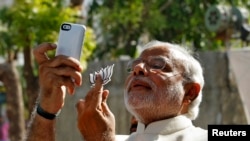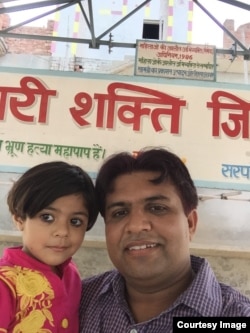In India, selfies of smiling fathers with daughters have flooded social media following a call by Prime Minister Narendra Modi, who hopes such pictures will boost a national campaign to combat female feticide. The prime minister borrowed the idea from a village head in the northern Haryana state, who has been battling to raise the status of women.
Within hours of Prime Minister Modi using his Sunday radio address to urge people to post selfies with the hashtag #SelfiewithDaughter, thousands proud fathers had tweeted photos taken with their daughters.
The Indian leader, who is savvy on social media, expressed optimism that this can revolutionize a national campaign to save the country's girls by creating a people’s movement.
The government launched a “Save Daughter, Teach Daughter” campaign earlier this year in a bid to combat the practice of aborting female fetuses due to the country’s deep seated preference for sons over daughters. This has led to a worryingly skewed gender ratio – for every 1000 boys up to six years old, India has 914 girls.
It was not just fathers in India who responded to Modi’s call – some in countries like Sweden also posted pictures with daughters.
The Indian leader understands what a good photo can do – on a recent trip to Beijing, a selife he took with Chinese premier Li Kequiang got more than 30 million hits.
The prime minister said he was inspired by a “Selfie with Daughter” initiative floated by the head of a small village, Bibipur, in Haryana State. Haryana has the country’s worst gender imbalance.
Village head Sunil Jaglan, who is spearheading a campaign to raise the status of women in the region, initiated a “Selfie with Daughter” contest last month. He began by posting a photo with his three and a half year old daughter – his latest effort to change centuries old patriarchal mindsets.
During a recent visit to the village, Jaglan told VOA that his campaign was sparked by the birth of his daughter in 2012.
He said when he distributed sweets to celebrate the arrival of his newborn daughter, his class mates and others thought he had a son. They could not believe that someone would distribute sweets at the birth of a girl.
Jaglan said nurses refused to accept the tip he gave, saying a girl’s birth did not merit the same generous tip as a boy.
Jaglan, who is now the father of two daughters, said he did not want them to grow up in such an environment. His efforts have yielded results – the sex ratio in his village is improving as the centuries-deep prejudice against girls begins to change.
Prime Minister Modi said a new hope is born by a campaign like the one in Bibipur, more so because it has begun in a region where the problem is most acute.
Modi said when the government’s campaign is adopted by an individual, by society, by a village, it gets added strength.
Social activists hope this latest initiative will not just be another photo opportunity, but will give a boost to India’s efforts to accord its daughters the same positions as it sons.











